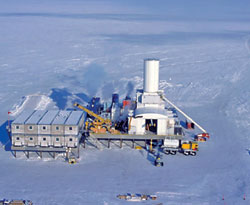What's new in exploration
Methane hydrate – oops. The last part of a two-year project to drill and produce methane hydrates is now complete. We reported on the first part in the Drilling Advances column of World Oil's May 2003 issue. The project is south of Kuparuk River field in the Alaskan Arctic. Drilling the Hot Ice-1 well began in March 2003, using a special slimhole rig. Maurer Technology Inc. was the principal investigator for the DOE-funded project, and used a specially designed Drill Smart system developed by Noble that allowed project participants to view continuous, live data and images from the platform. In addition, vehicles called rolligons, which use large, wide tires, eliminated building an ice road. Drilling took place only in winter, so operations were suspended in April 2003 until this winter.
The rig – itself an innovation – is called the Arctic Platform and is a lightweight, 100 x 100-ft aluminum drilling platform elevated 12 ft above the frozen tundra on specially designed auger-like steel legs. The platform is compact and modular, and can be safely transported by air or by rolligons. It was developed by Anadarko Petroleum. It should allow extension of the operating season above the Arctic Circle, when the tundra has thawed. That's the background, and now for the bad news. After two winter seasons of drilling the less than 3,000-ft well, it turned out that there were no methane hydrate accumulations, although significant gas shows were encountered. “The absence of hydrate at the site is in itself a significant scientific finding,” said Tom Williams, vice president with Maurer Technology Inc. and a member of the drilling team. “Based on detailed evaluation of log data from adjacent offset wells, the Hot Ice-1 was expected to encounter a significant thickness of reservoir quality sands in the Upper West Sak unit. The sands were there just as expected, but we found free gas and water rather than hydrate in the hydrate stability zone. Figuring out why will require a thorough post-mortem analysis of the core, log and seismic data from the well.” This is an especially disappointing setback for those who are investigating methane hydrate as a resource. This is because, at best, its economics are probably marginal, especially in deep water where it is believed to be more abundant; so, it is important that methane hydrate exploration has a high success rate. As Williams added, “Clearly, the model for distribution of methane hydrate on the North Slope may be more complex than we previously thought.” For this editor, what is needed is a no-holds-barred methane hydrate production test involving long, large-diameter horizontals, with overlying pipes for delivery of hot water, possibly even steam or chemicals, and anything else that would help achieve the following goal. That goal should be maximum production for an extended period of time. If next year's planned production test at Mallik – which is just across the Canadian border and is known to have rich hydrate deposits – could accomplish, say, a half million cubic feet a day flow for two months, everyone would be truly inspired; all else is just so much hardware. Let's hope that the Mallik researchers “go for the brass ring” and have a rousing success. Lots of bids. Central Lease Sale 190 for the Gulf of Mexico drew 829 bids – a six-year high. About 23 million acres were offered in 4,324 tracts, garnering $369 million in winning bids from 83 companies. The sale was held on March 17, but leases will not be finalized until Minerals Management Service has reviewed them for fair market value. Some 60% of the bids were on the shelf, which is likely a reflection of the royalty relief rule that was finalized earlier this year and is part of MMS's Deep Gas Initiative. Another 73 are in deep water ranging between 2,600 and 5,300 ft, while 91 are in ultra-deep water, beyond 5,300 ft. The acreage efficiency leader, that is, largest number of bids for the least amount of money, was Magnum Hunter with 55 bids totaling $8.4 million, followed closely by Remington, with 25 high bids at $8.1 million. At the other end of the price range was Amerada Hess, bidding $40.7 million for 17 tracts, followed by Stone Energy with 8 offers at $15.5 million. ChevronTexaco was active, offering $10 million for 29 tracts, as was BHP Billiton, at $18.5 million for 32 leases. The highest bid for a single tract was $35.3 million, offered by the partnership of Nexen, Anadarko, BHP Billiton and Union Oil. Although the high bid usually gets the tract, MMS will review the bids to make a final award decision, based on such things as fair value and work history. In a related matter, US District Judge Royce Lamberth ordered a shutdown of the US Dept of the Interior (DOI) web site, which includes the MMS site. This is the third such directive from the court, the first being in December 2001. The reason cited is because DOI had not sufficiently protected American Indian Trust information online, such as oil and gas royalties, from computer intruders. AAPG will have three, half-day sessions (2 oral, 1 poster) on geochemical exploration techniques at its Annual Meeting in Dallas, April 18 – 21. These 30 presentations are sure to bring out some interesting views from all sides, so don't miss them.
|
|||||||||||
- Prices and governmental policies combine to stymie Canadian upstream growth (February 2024)
- U.S. producing gas wells increase despite low prices (February 2024)
- U.S. drilling: More of the same expected (February 2024)
- U.S. oil and natural gas production hits record highs (February 2024)
- Quantum computing and subsurface prediction (January 2024)
- U.S. upstream muddles along, with an eye toward 2024 (September 2023)





